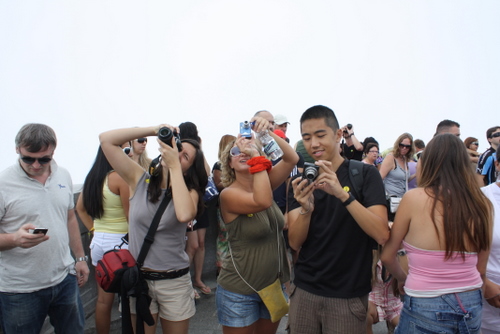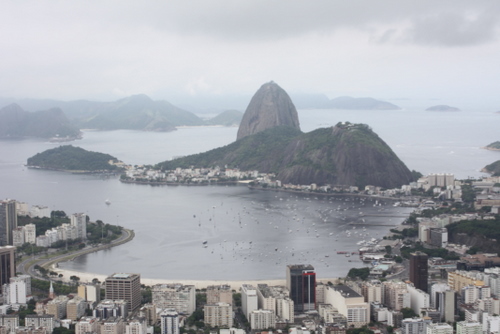Right now, as I am writing this, I am sitting on the airplane somewhere over the Atlantic Ocean back home to Europe. A long trip is over and after almost five weeks of traveling, I have seen a lot and opened my horizon even more. It is the second part of my detailed story and short resume of my trip in South America.
To see what happened before, check out my story about Sao Paulo, Santa Cruz and La Paz. I also provided some more pictures.

After being in La Paz, Vivi and I headed to the Titicaca Lake to the city of Copacabana. Titicaca is not only one of the biggest lakes in whole South America; furthermore it is the highest lake worldwide. It's shared between Bolivia and Peru. We stayed there for two days, seeing the lake itself, the "Isla del sol" and hiked up mountains in the surroundings. I had my first approach with Inca ruins and it was definitely amazing.

Copacabana, Boliva
Painful hours away sitting on a bus, we went to Cusco in Peru. The city was really nice. You could easily tell that this city has everything a tourist could want: very nice bars, restaurants with good food, police officers that maintained the safety of tourists and everything that might be interesting for them.

Moray, Peru
We stayed there a couple of nights and did some sightseeing inside the city and close by to an old Inca-archeological ruin named Moray!

Machu Picchu, Peru
Machu Picchu, not too far away from Cusco, was definitely one of the highlights of the trip. Getting there by a (expensive and slow) train, we could see the beautiful nature. We arrived there around noon and bought our (expensive) ticket and decided to hike up to Machu Picchu instead of taking the (expensive) bus. What is Machu Picchu? It is an old Inca-city built on top of a mountain. The city was built in a way that, looking from the side, you can realize the shape of face. Hiking up there and simply being there was great. This was one of the most breath-taking views I've ever had in my life. Besides feeling being "abused" as a tourist from the prices, it’s definitely a must-do thing!

City of Cusco, Peru
Uyuni was next on our endless-list of things we wanted to do.Getting from Cusco to Uyuni in Bolivia is a story itself. There is no direct bus connection from Cusco to Uyuni, so you have to change at least in La Paz, which is about 13 hours away to change in La Paz and then again about 12 hours by bus. We booked the bus to La Paz and went off to Bolivia around 9pm. After not more than two hours on the bus, it did stop already and all the lights were suddenly off. After a while, the bus driver and his assistance came and asked if there was smoke inside the cabin, which was in fact true - the battery or electric was dead. But instead of fixing it, calling another bus or bringing us to a hotel, the bus driver thought it's better to wait in the middle of nowhere without water and food until 9am when he can reach a technician, who could come after two hours and perhaps might be able to fix it (or not). Of course the passengers got angry and "we the passengers" wanted them to send us another bus. Only after calling the police and making a big thing out of it, things started to become better. The police of Peru really came to help us and were waiting with us until the bus company sent another bus, but by that time we had already a delay of about eight hours. I don't even want to think about it how much more the delay would be without taking action…
Arriving in La Paz we could get another bus to Uyuni - At the end, we spent the whole time from Friday night until Sunday morning on the bus, how we felt, I don't think I have to explain...

Salar de Uyuni, Bolivia
Finally Uyuni! Right after our arrival we actually wanted to rest a bit from the long ride, but due the lack of time and our plan to see this, there was no time to rest. Two hours after being in Uyuni we booked a tour to the famous salt lake (salt desert in dry season). The tour was amazing and definitely a highlight! Being on a big 4WD-SUV we did most of the tour off-road. It was so much fun and I could see the beautiful landscape of that area. Simply breathtaking! Vivi and I went together with two Norwegians, a German and a French girl. It was great fun playing UNO and I used to opportunity to learn more about Norwegian, a place in Europe I haven't been so far.

Off-Road in the nature, Bolivia

Free Flamingos, Bolivia
Potosi, the highest city in the world, was next on hour agenda. The city is famous of course of being 4000 meters above sea level and for its silver mines. People there say that Spain gained so much silver out of it, that they could actually build a bridge made of silver from South America to Spain...
We didn't have enough time to see the mines, so we spent some time to explore the beautiful old city before heading to the next city.

Potosi, Bolivia
The capital of Bolivia, Sucre, was the next destination. We spent not more than a night and the morning there, but we could use the short time we had to do a little bit of sightseeing. Luckily we had a flight to Santa Cruz and didn't have to go by bus, as those bus rides are really painful (when you are taller than 1,80m).

Sucre, Bolivia
Staying again two nights with Vivi’s parents in Santa Cruz, it was good to have a rest of all those moving and being on a bus, but as you can expect, the journey was not over yet...

Rio de Janeiro, Brazil
My flight to Rio de Janeiro was my one hundreds one. It was a good one!

Couchsurfing host Rogério and me
Arriving in Rio de Janeiro we went straight to our Couchsurfing-host place, or actually aunt’s place located at Copacabana beach. Rogério hosted us together with Andy from Singapore, Silvy from France and Tai from Espiritu Santo (Brazil). We had a great time together. We went to see the Jesus-statue, the Sugar loaf and one of the reasons why I actually booked the flight to South America: The carnival of Rio de Janeiro, the most famous one in the world.

Taking pictures with our Co-Couchsurfers, Silvy and Andy

Sugar loaf, Brazil
We spent almost a week in Rio de Janeiro and had a great time with the Couchsurfers playing “international UNO”, seeing how locals celebrate carnival and how tourists do, being on the beach.

Local carnival (Blocos), Brazil

Tourist carnival (Sambodromo), Brazil
We also had a bad experience being there. Rio de Janeiro is famous for being a dangerous city and it for sure is. Although nothing or at least not too much happens to you if you are outside on the street during certain times and always are close to more people, but even then during the day not far away from masses of people, Vivi and I took some pictures in the center of downtown as a group of three people tried to rob us - Luckily a taxi was not too far away and we could escape by taking the taxi. You can imagine that I almost got paranoid walking around in the city after that point and was also more than happy somehow being away again. I guess people living there really got used to it and respect all the rules that apply to stay more less safe, although that means that you are really limited by time and location to avoid trouble such as robberies, speed-kidnapping etc.

Lapa, Rio de Janeiro, not far where people tried to rob us
Close to Rio de Janeiro is the lovely city of Buzios. We spent there two days at the beach and simply resting and enjoying some time without any agenda.

Buzios, Brazil
Sooner or later, also a long trip is over. We had to return to Rio de Janeiro were we stayed a night at Vivi’s cousin and then go to Sao Paulo again. We could stay there with friends of Vivi who were really nice. They took us to some other nice places of Sao Paulo that I haven't seen before.
But here I am now, I left the airport of Sao Paulo and sit on the plane of Lufthansa back to Europe, back to real life of work, after adventures, amazing and unforgettable trip to South America...
See all photos on the photoblog
Open interactive map of the way-points
South America Tour 2011 - View larger map